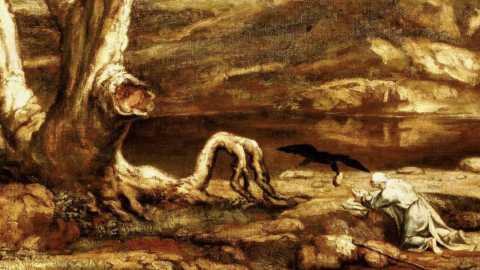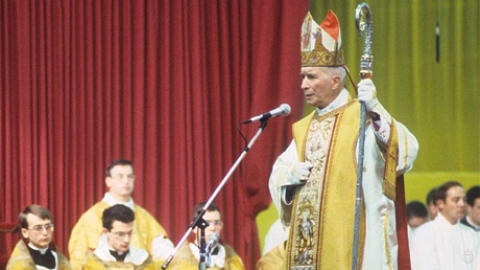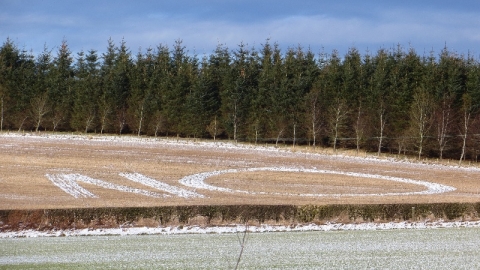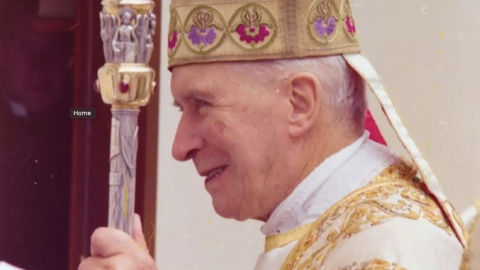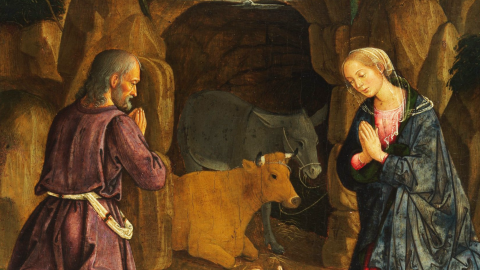Who was St Declan?

Pilgrims assist at Mass at St Declan's oratory in Ardmore
It's nearly time to dust off the walking boots! The society’s pilgrimage from August 20th to 22nd is a route that follows in the footsteps of St Declan who in the 5th Century walked 110 km from his monastery in Ardmore, Co. Waterford to visit St Patrick in Cashel; the apostle of Ireland at the time was preaching and converting the King of Cashel Aongus MacNatfrich to Christianity.
But what do we actually know about St Declan?According to Fr Patrick Power’s (1862-1951) book ‘The Life of St Declan of Ardmore' and other sources, Declan was born to his father Erc Mac Trein and mother Deithin, and was of noble blood. His birthplace is thought to be around Lismore in Co. Waterford. According to a legend, on the night he was born a great ball of fire rested over the dwelling house along with a choir of angels, thus marking out the child as blessed by God from the moment of his birth. His mother lifted up her newborn baby and his head hit against a stone. Today this is called St Declan’s stone where pilgrims crawl through the cavity to dispel themselves of disease and illness. Colman, a holy priest explained to his parents that the child was blessed and told them that he must be reared with extra care and discipline.
At 7 years of age he started his studies under the care of his foster father Dobhran who was his paternal uncle. After many years with his uncle who loved him dearly and who left to Declan his dwelling place (according to some sources this may have also been Declan’s birth place) he was sent to a holy man named Dioma to further his studies. Whilst there his reputation grew and many disciples and followers came to him.
Declan decided to travel to Rome to study and there he met and became firm friends with Ailbe, the Bishop of Emly. During his stay he was ordained priest and bishop by the pope of the time. On his return journey to Ireland on an Italian highway he met Patrick who would later become the Patron Saint of Ireland. They formed a bond of friendship during this encounter.
One day as he was saying Mass, a black bell mysteriously appeared on the altar and St Declan took this as a sign of God from which he took comfort and courage for the journey ahead as he knew he would face many challenges. This bell is called ‘Duibhín Deaglán’. On one occasion when they reached the coast there was no ship available to them for their onward journey and St Declan rang his bell and mysteriously an empty ship appeared out of the mist to take them on their way. Another legend tells us that St Declan mislaid his beloved bell and whilst on a ship prayed for its return and looking overboard saw the bell sitting on a rock. He told his companions that wherever the bell would land he would build his monastery and the bell came ashore at Ardmore.
Declan built his monastery and over time it grew into a city as did his reputation as a holy man; many miracles were attributed to him from curing people of plague to giving sight to the blind and the lame walk.
Patrick, who he had met on his journey, had subsequently been appointed a bishop by pope Celestinus and as mentioned earlier, was in Cashel preaching and converting the King of Cashel and many others to Christianity. Ledban, the King of Deise, was antagonistic to Patrick and there was great trouble brewing so an Angel of the Lord appeared to Declan to tell him that he must make a journey to Cashel before matters escalated and the Irish people would gravely suffer as a result.
Declan made his way over the Knockmealdown mountains, passing through Mount Melleray, Lismore, Ardfinnan, Cahir and onwards to Cashel - the route we know today as St Declan’s Way. Arriving at Cashel he was greeted hospitably by Patrick and the King and he encouraged the people to denounce Ledban and follow Patrick instead. A new King of the Deise was selected by Declan and Patrick, who was named Fergal Mac Cormac; he led his people in the grace of God and Ledban was banished and never heard of again.
St Declan continued his mission converting multitudes of people to Christianity in the Deise and beyond. But later on in his life, in order to better commune with God in solitude, he retired to a cell (Disert Deaglán) by the sea where he could pray and grow to love God even more.
As the time of his death was approaching he left his cell and returned to his monastery. He called his priest Mac Liag to him to administer the sacraments and there he received his final communion. He spoke to his disciples and followers and told them to continue to live holy lives and to do God's Holy will. He blessed and kissed them in a token of love and peace and drew his final breath.
His grave, according to tradition, is located in what is now called St Declan’s Oratory. His Feast Day is celebrated on 24th July. So as we walk in his footsteps on August 20th - 22nd, let us pray to this wonderful saint that he might again restore the people of Ireland to the faith they once held so dear.
